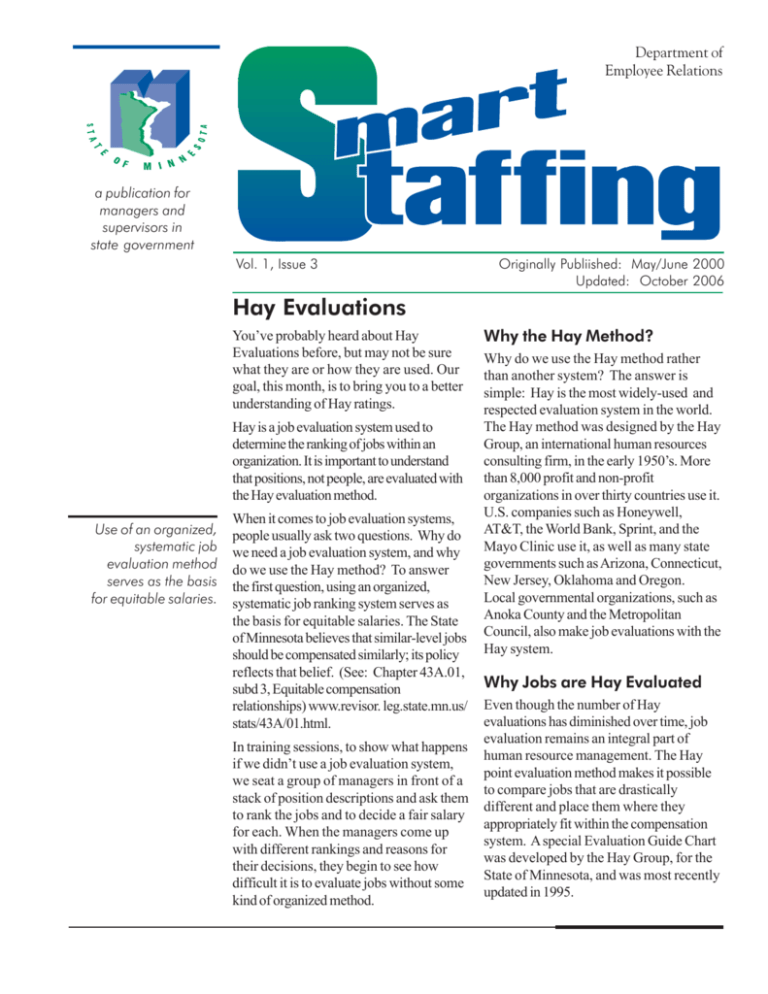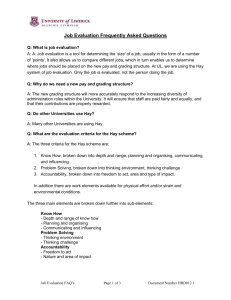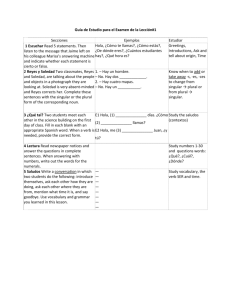May-June 2000.pmd
advertisement

Department of Employee Relations a publication for managers and supervisors in state government Vol. 1, Issue 3 Originally Publiished: May/June 2000 Updated: October 2006 Hay Evaluations You’ve probably heard about Hay Evaluations before, but may not be sure what they are or how they are used. Our goal, this month, is to bring you to a better understanding of Hay ratings. Hay is a job evaluation system used to determine the ranking of jobs within an organization. It is important to understand that positions, not people, are evaluated with the Hay evaluation method. Use of an organized, systematic job evaluation method serves as the basis for equitable salaries. When it comes to job evaluation systems, people usually ask two questions. Why do we need a job evaluation system, and why do we use the Hay method? To answer the first question, using an organized, systematic job ranking system serves as the basis for equitable salaries. The State of Minnesota believes that similar-level jobs should be compensated similarly; its policy reflects that belief. (See: Chapter 43A.01, subd 3, Equitable compensation relationships) www.revisor. leg.state.mn.us/ stats/43A/01.html. In training sessions, to show what happens if we didn’t use a job evaluation system, we seat a group of managers in front of a stack of position descriptions and ask them to rank the jobs and to decide a fair salary for each. When the managers come up with different rankings and reasons for their decisions, they begin to see how difficult it is to evaluate jobs without some kind of organized method. Why the Hay Method? Why do we use the Hay method rather than another system? The answer is simple: Hay is the most widely-used and respected evaluation system in the world. The Hay method was designed by the Hay Group, an international human resources consulting firm, in the early 1950’s. More than 8,000 profit and non-profit organizations in over thirty countries use it. U.S. companies such as Honeywell, AT&T, the World Bank, Sprint, and the Mayo Clinic use it, as well as many state governments such as Arizona, Connecticut, New Jersey, Oklahoma and Oregon. Local governmental organizations, such as Anoka County and the Metropolitan Council, also make job evaluations with the Hay system. Why Jobs are Hay Evaluated Even though the number of Hay evaluations has diminished over time, job evaluation remains an integral part of human resource management. The Hay point evaluation method makes it possible to compare jobs that are drastically different and place them where they appropriately fit within the compensation system. A special Evaluation Guide Chart was developed by the Hay Group, for the State of Minnesota, and was most recently updated in 1995. Hay evaluations are conducted for three main reasons: * Managerial/integrating skills. A new position doesn’t seem to fit into any existing class. A position is part of a class study. The appropriate level of a job can’t be determined, or there is a major dispute about its level. Raters determine the points to be assigned for Know-How based on the separate choices they make for each of KnowHow’s three components. Jobs are rated by a Hay rating committee to help ensure a broader perspective than one individual could provide, yet still provide statewide consistency. The Hay committee is comprised of three to five human resource professionals from agency human resource offices and the Department of Employee Relations (DOER) - Staffing Division, all trained in the Hay method. All Hay raters must meet the training and experience certification standards established by DOER and approved by the Hay Group. While evaluating a job, Hay raters focus on four elements of the job: Know-How, Problem-Solving, Accountability and Special Conditions. What Hay Evaluators Look For When evaluating a job, Hay raters always look at three elements of the job: Know-How, Problem-Solving, and Accountability. A fourth element, Special Conditions, may be considered for some jobs. A separate evaluation page exists for each of the four Hay elements, with grids identifying points or numbers from which to choose. The points on the grid increase at a 15% rate; the fixed increase is based on the scientific concept of “just noticeable difference.” The concept means, for example, that a change in Know-How required to perform job “A” versus job “B” is only noticeable when there is an increase or decrease of at least 15% on the Hay interval scale. Know-How Know-How is the body of knowledge an employee needs to do any job. It is made up of three parts: * Technical or specialized knowledge. * Human relations skills. Technical or specialized knowledge: Does the job require specialized knowledge, such as accounting, engineering or computer programming, or an understanding of certain procedures? Does an employee need to know why things are done or just how they are done? Managerial/integrating skills: Managerial skills are needed to plan, organize, direct and integrate progressively more diverse work activities. Human relations skills: What kind of human relations skills are needed for the job? Human relations include working relationships with people inside and outside the organization, face-to-face interactions and telephone conversations. Does the job require a lot of personal interaction or very little? Some people believe that the size of a budget and the number of people reporting to a position are the biggest factors determining a Hay rating. Actually, jobspecific Know-How is the most important factor. Like the playing field for football, it defines the boundaries within which the action takes place. Problem-Solving Problem-Solving is the way in which employees make decisions and solve problems. Logically, Hay Problem-Solving points are determined by the direct application of Know-How to making decisions and resolving problems, such as: analyzing, evaluating, creating, reasoning and arriving at conclusions. In some jobs, employees encounter routine problems; in other jobs, the problems are less w w w. d o e r. s t a t e . m n . u s predictable. Hay raters want to know what the problems are and what process an employee has to go through to solve them. Are there procedures or policies that must be applied? Are the choices “yes” or “no” or are there multiple choices? Are the situations encountered usually the same, or do employees face new problems for which there are no models? Accountability Accountability is the responsibility for actions and their consequences, and the measured effect of the rated job on end results for the organization. Accountability has three components: The freedom to act on decisions. The size of the budget or magnitude of influence. The way in which actions affect the end results in the agency. Freedom to act: What constraints are put on an employee in this job? Are there set procedures to follow or does the employee have broad authority to carry out management’s directions? What kind of decisions are made by a position’s supervisors? Magnitude: What sort of budget does the employee in this position control? Does this allocation consist mostly of salaries? If there isn’t any budget, what influence does the employee have over what goes on in the agency? Relationship to end results: How does the employee influence the business of the agency? Directly or indirectly? Does the employee give advisory or interpretive services for others to use in making decisions? Is the job an informationrecording one? Does it provide a necessary service, but with a relatively small effect on the business of the agency or the state? Special Conditions Special Conditions is a fourth aspect of some jobs and refers to the conditions under which those jobs must be performed. Where hazards, unpleasant environment, particular physical demands, or intense sensory attention are a significant element of the job, Special Condition points are given. How Rating Decisions are Made Every job that is evaluated receives the same treatment. Jobs are ranked within the context of all statewide positions, from the Governor on down, not just within the context of one agency within the executive branch. The Hay rating of a job is the sum total of Know-How, Problem-Solving, Accountability and Special Condition points. After the position has been evaluated against standard benchmark jobs, the Hay raters review their initial ratings by comparing them with existing ratings for similar jobs. This process is called “sore thumbing” because the ratings are reviewed one last time to see if any of them “stick out like a sore thumb.” If irregularities or discrepancies are discovered during this process, the Hay committee discusses the ratings and, by consensus, decides whether any changes are needed before finalizing the rating. The total number of points indicates where the job ranks in relationship to other state job classes and provides an approximate salary range. Preparing For a Presentation Because job evaluations are so important, Hay presentations are sometimes the cause of anxiety. We want to reduce Hay anxiety by giving you an idea of your role and what to expect during a Hay evaluation. To serve you, we provide Hay Briefing Sessions. The Hay Briefing Session Hay Briefing Sessions review what goes on during a Hay Evaluation, who the participants are, and how to prepare for your presentation. Everyone who has to make a Hay presentation can benefit from a briefing session. Briefings are conducted by human resource staff from agency human resource offices or the Department of Employee Relations, Staffing Division, at the request of Hay session presenters. Resources: Information for this article was provided by Wayne Veum, Chief Classification Analyst, and the State of Minnesota Hay Advisory Committee. Hay Presentation Tips If your job, or one you supervise, is being evaluated, you may be asked to give a presentation to a Hay committee. Hay raters analyze the position description and the organizational chart when they evaluate a job, but they rely on job presenters to fill in the gaps and add context to the position. Here are four tips which may be useful: 1) Make your presentation as concise as possible. 2) Focus on the job’s Know-How, Problem-Solving, Accountability, and any Special Conditions components. The more focused a presentation is, the easier it is for raters to achieve an accurate rating. 3) Anticipate questions and some discussion. 4) Focus on the job’s duties, not on the skills of the person in the job now.





